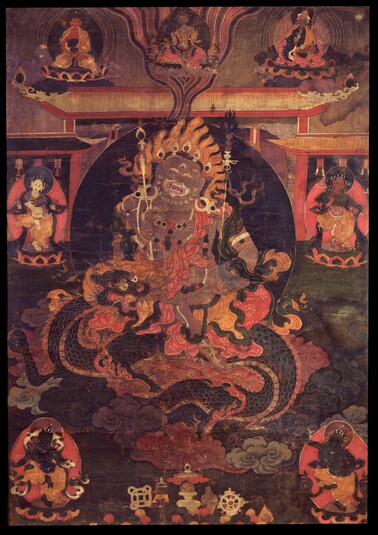
Item: Jambhala (Buddhist Deity) - White
| Origin Location | Tibet |
|---|---|
| Date Range | 1800 - 1899 |
| Lineages | Gelug and Buddhist |
| Size | 53.34x37.47cm (21x14.75in) |
| Material | Ground Mineral Pigment on Cotton |
| Collection | Tibet House, New York |
| Catalogue # | Gift of Shelley & Donald Rubin |
Classification: Deity
Appearance: Wrathful
Gender: Male
White Jambhala (Tibetan: dzam bha la kar po): a Wealth Deity - emanation of Avalokiteshvara.
With one face and two hands he holds in the right a stick of gold and in the left a mongoose. A katvanga staff rests against the left shoulder. Wrathful in appearance with the hair flowing upward like flames he is adorned with jewel ornaments and silks of various colours, riding on the back of a dragon - sporting amongst the clouds.
At the top center is the bodhisattva Avalokiteshvara, emanating amongst rainbow light, with one face and two hands, seated in a relaxed posture. To the right is Guru Rinpoche holding a vajra in the right hand and skullcup and vase in the left. Wearing a lotus hat and the three sets of robes he has a katvanga staff resting against the shoulder. Seated at the top left is the buddha Amitabha, red in colour, with the hands in meditative equipoise.
Below Amitabha is yellow Ratna Dakini, holding a jewel in the right hand and a vase in the left, dancing on the left leg. At the bottom left is blue Vajra Dakini, holding a vajra in the right hand and a monk's begging bowl in the left. At the upper right is red Padma Dakini holding a lotus in the right hand and a hook in the left. At the bottom right is green Visva Dakini holding a visvavajra (double vajra) in the right hand and a wish-fulfilling jewel in the left. Strewn along the bottom are various symbols of wealth and opulence such as vases, a parasol, a golden wheel and wish-fulfilling jewels. The main figure is placed in front of a stylized gate of Chinese origin. The dragon is also richly painted and drawn in the Chinese style.
The white form of Jambhala, belonging to the Kriya class of Tantra, is an emanation of Avalokiteshvara and was popularized by Jowo Atisha, founder of the Kadampa School.
J.Watt 5-98
Collection of Tibet House: New York (Repatriation)
Tradition: Nyingma Deity Paintings
Buddhist Deity: Jambhala Main Page
Subject: Wealth Deities Main Page
Buddhist Deity: Jambhala, White, Main Page
